Foods Of the Arab World – A History (Part 2)
By: Habeeb Salloum/Arab America Contributing Writer
Most of the rich sweets one sees in the food stalls across North Africa, especially in Morocco, were developed in Arab Spain and brought to North Africa by the expelled Muslims.
The luxurious Andalusian culinary heritage gave the Moroccan kitchen an aura of regal splendour, maintaining the traditional in the contemporary. Today, in the homes of the wealthy, especially in Fez, entertaining guests is a ceremony full of colour and romance.
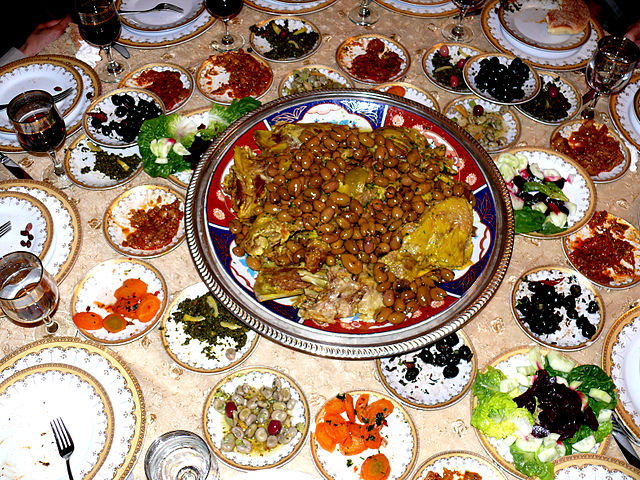
From the Iberian Peninsula a good number of these spices, herbs, vegetables, fruits and prepared dishes spread to the other parts of Europe, then later to the Americas, some even retaining their Arabic names. Today in many of the European languages many foods and spices still carry their Arabized Asiatic names. And this linguistic contribution continues into our times.
The Arab larder of dishes is today so large that it has become a world cuisine par excellence. Some culinary historians have stated that this abundant table includes, perhaps, 40,000 dishes only exceeded by the Chinese who are said to have a kitchen of some 80,000 dishes.
Turkey, too, had played a great influence in the development of Arab cuisine. Its forerunner, the Ottoman Empire, laid the basis for modern Turkey’s gastronomic tradition. According to culinary experts, the Turkish kitchen, along with those of the Chinese and the French, is one of the three great cuisines of the world. The large Ottoman Empire that had included the whole Middle East, most of North Africa and all the Balkan nations, came into contact with many cultures and their foods.
Hence, in the march of history many influences crept into the food of the huge Ottoman Empire. The old civilizations of the Middle East, Arabs, Persians and Byzantines all had a part in the creation of the Turkish kitchen.
Part of the Ottoman Empire’s realm included the Greater Syria region which I consider to be the heart of contemporary Arab cooking. This region consists of Syria, Lebanon, Jordan and Palestine. The kitchen of this area did not develop by accident but took shape century after century as culture after culture flowed through the Middle East.
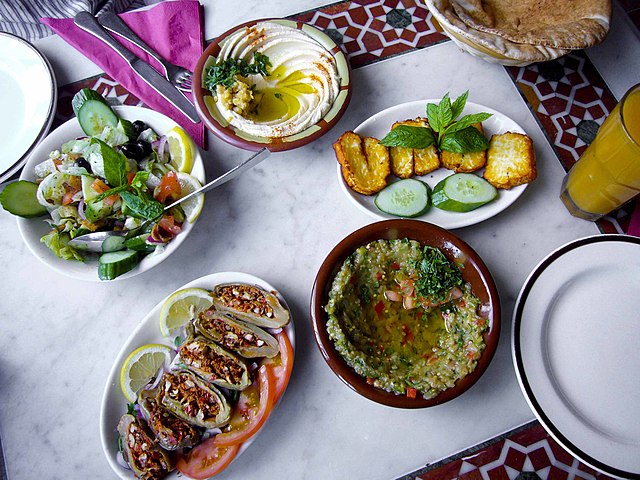
Within this region the great cosmopolitan cities of Aleppo and Damascus became the centres for the development of the culinary arts. The wealthy, with much leisure time, were able to create new dishes and evolve the old. Cooks in the palaces of the caliphs and emirs vied with each other with their creations.
What helped immensely in the invention of new foods was that Damascus, along with its sister city of Aleppo, were at the western end of the wealth producing Silk Road.
No less important, in the creation of both cities’ affluent lifestyle, was the Frankincense Route from where the perfumes and spices brought by Arab dhows to southern Arabia were transported overland to these cities.
Today, memories of the exotic goods carried on these routes are to found in the souks of Damascus and Aleppo.
In the ensuing centuries, other Middle Eastern cities only copied the foods of these historic urban centres. What is known today as Lebanese, Syrian, Jordanian or Palestinian food was originally developed in the kitchens of these historic cities.
It is said that new dishes are not created by peasants but by those with time to spare and those who have the money to experiment with new ideas.
Visitors need only enter the old quarters of Aleppo or Damascus and breathe in deeply the aroma of exotic spices, in order to feel that they are in a medieval world of action and colour.
The culinary art of Aleppo, Syria’s second largest city, is documented from the misty days of early civilizations until our times.
However, it was only under the Islamic Umayyad and Abbasid dynasties and during the 10th century rule of Sayf al-Dawla al-Hamadani, when the city acted as a medieval trading centre at the end of the Silk Road, did Aleppo reach its pinnacle as a commercial and cultural centre in the Middle East.
Its vital role lent to its development of an exquisite cuisine. In later centuries, Mongols, Mamelukes, Ottomans and the French ruled for a while, then departed, enriching even further the city’s culinary arts.
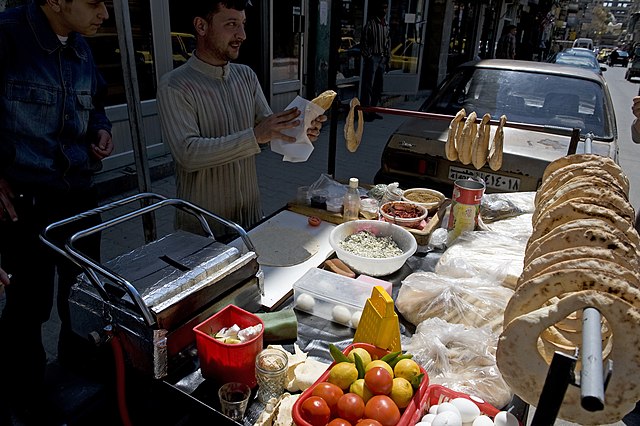
Today, one has only to enter the old city to see a mirror of its medieval world. The network of 15th century stone-roofed streets are infused with a bewildering mixture of people at work or on the move.
This living picture of daily activity depicting what was then of the medieval world is reflected in the city’s repertoire of unusual recipes – many going back to the court cuisines of the past – while others show the influence of the large Armenian community in the city.
No one dining on food flavoured with pomegranate syrup, grilled meat smothered in yogurt, barbecued meat balls with sour cherries, a green wheat pilaf called freekeh or on one of the dozens of varieties of kubba (ground lamb mixed with bulgar and spices), will forget the world-class cuisine of that city.
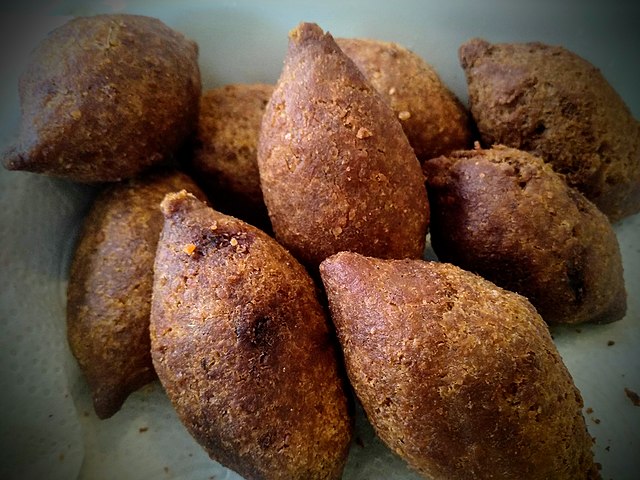
Aleppo, noted for its spicy dishes and array of vegetables and fruits mixed with stews, its kababs and kaftas, and its variety of dips and sauces vies in competition with the oldest continuously inhabited city in the world, Damascus.
Syria’s capital city boasts of its gastronomy proclaiming that its ancient past has given it its future.
A Byzantine Emperor called it `the light of the Orient’; one of history’s greatest travellers, the 14th century Ibn Battuta, praised the charming cities of Syria but proclaimed Damascus at the pinnacle;
The writer Maurice Barres is reported to have said `Damascus is not a mere area of land, it is the place of the soul’; and the Prophet Muhammad reportedly refused to enter the city, which he labelled `heaven on earth’ preferring to wait for the heavenly Paradise.
Through the centuries, such have been the words with which visitors have described Damascus.
Under the Umayyads, the first ruling dynasty of the Islamic Empire, Damascus became the capital of a realm that stretched from China in the east to the heart of France in the west. For a hundred years the wealth of this vast domain enriched the city and it became the most illustrious capital on earth with a celebrated cuisine.
Today, the culinary art of the city is alive and well. There is no doubt that Eternal Damascus, where Alexander the Great and the Arab caliphs once strolled has, after centuries of civilization, developed one of the finest of the world’s kitchens. The words of a medieval traveller who wrote, “Damascus serves the choicest of foods” are still applicable today.
Next to Syria is Lebanon, a small country with a large selection of delicious dishes. The country takes pride in its cuisine and the Lebanese have made sure to take it with them wherever they emigrated.
These dishes, common throughout the Greater Syria region, have been exported throughout the world by the Lebanese as they settled elsewhere. The name ‘Lebanese’ for Arab Middle Eastern foods has now become a common identity for these dishes.
The Lebanese have been so successful at marketing their food worldwide that its Aleppan and Damascene heritage have been forgotten. In the Arabian Gulf, countries where there are thousands of restaurants owned by people from the Greater Syria area, even the Syrians and Palestinians call the food offered in their restaurants, ‘Lebanese Food’.
On the other hand, no matter what the food is called or from what part of the Greater Syria area it comes, most of the dishes are healthy, nutritious, appealing and tasty.
In the area of appetizers, a Lebanese speciality, this part of the meal is even more renowned than the Spanish and their tapas. No Lebanese will consider a meal complete without the serving of from 6 to 100 appetizers. It is best to skip the main meal when dining in Lebanon. For me, the appetizer component of the meal is a gourmet world gone mad.
Continuing with the regions of the Arab Middle East, as I have explained before, Iraqi cuisine has a long history going back thousands of years. However, it was in the medieval era when Baghdad was the capital of a large Muslim Empire that the Iraqi kitchen reached its zenith.
After the destruction of Baghdad by the Mongols in 1258, this world-class cuisine declined, but was somewhat revived in the last century by the commercial and cultural interaction with the countries of the Mediterranean area and the world beyond.
Today, the foods of Iraq reflect this rich inheritance as well as strong influences from the culinary traditions of Turkey and Iran and the Greater Syria area. Because of all these traditions and complex influences, Iraqi cuisine is enormously rich and varied.
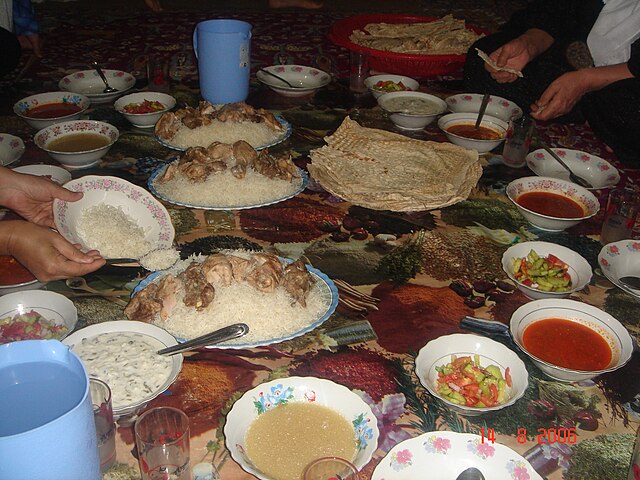
Moving south to Yemen, the region known to the Greeks and Romans as “Fortunate Arabia” or Arabia Felix, we find an indigenous cuisine almost as ancient as the country itself.
The origin of Yemeni cuisine goes back to the ancient civilizations of South Arabia. Controlling the rich trade in frankincense, myrrh and the spices brought from India and beyond, then sold to the kingdoms of the North, these south Arabian countries prospered. Through the years, a number of the priceless condiments in which these South Arabians traded entered their culinary art and they developed a tasty cuisine.
Yemenis love hot spicy foods prepared with many seasonings, garlic and a good number of herbs, especially fresh coriander and mint leaves. Fenugreek is the most commonly used of the spices, forming the basis of an everyday paste-sauce called hulba – found with all meals and added to almost every non-sweet dish.
The collection of all of the cuisines of the countries of West Asia have been adopted into the Arab world’s Gulf region.
The truly cosmopolitan people living in the Arab Gulf countries, which include Bahrain, Kuwait, Oman, Qatar, Saudi Arabia and the United Arab Emirates, have created a rich modern Arab Gulf kitchen.
These include, besides the foods of Iraq, Iran and the Indian sub-continent, the foods of the Greater Syria region. Granted there are many indigenous dishes, such as kabsa, mansaf and kharoof mahshee but the Gulf countries have also taken on new tastes and foodstuffs that have become part and parcel of the region.
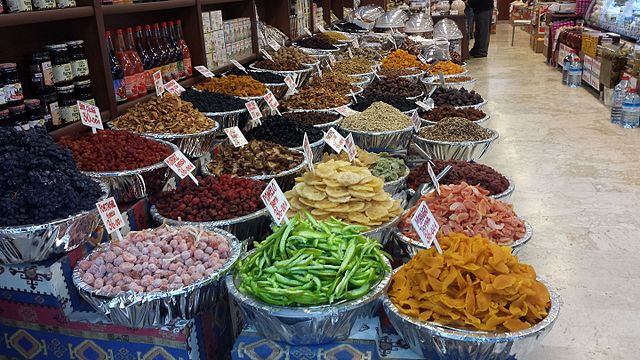
In the main, the traditional food of the Arab Gulf countries has evolved to fit into the modern age. On a smaller scale, the foods of the North African countries from Egypt to Morocco and those of the Western and Far East countries have crept into the kitchens of these Arabian lands. The dishes of all these nations have been taken on either as is, or modified to suit the tastes of the local people.
Oil wealth has made it possible to purchase the best ingredients in the world and from every country in the world. As well, the millions of people who came as tourists or to work in this region, bringing their foods with them, have been instrumental in the great innovations in the kitchens of these countries.
Many of the dishes, especially those of the Greater Syria region, are now truly incorporated into the cuisines of the Gulf states. Even better still, these dishes are now served enhanced with tidbits borrowed from other lands, making them much more appetizing than when they came from their former homelands.
Many of the new generation likely have no idea that when they enjoy their hummus bi tahini, tabboula and muhammara, that these dishes did not exist in their countries during the past ages. In my view, what a marvellous transformation!
My travels through these Arab Gulf countries have convinced me that in this part of the Arab world the evolvement of Arab food has allowed it to become a world-class cuisine – on the same level as the dishes of Baghdad were in the medieval ages. Hence my Arabian Nights Cookbook: From Lamb Kebabs to Baba Ghanouj (Vermont: Tuttle Publishing, 2010), which I consider to be a prototype for exposing this cuisine to the world.
As for today, Arab cuisine has made its mark.
From the Arabian Gulf to Morocco, many of these rich historic and modern Arab foods, inherited, then developed by the Arabs, and also created by these peoples are still, to some extent, culinary secrets hidden behind an eastern veil.
However, since the world is becoming more and more cosmopolitan and internet-friendly, the future of these foods is bright indeed.
Always tasty, enticing, healthy and nourishing, they will not remain tucked away for very long. Today, in many of the large Canadian, American and European cities, Arab breads, couscous, falafel, hummus, both meat and vegetable pies, and tabboula are to be found in corner cafes and restaurants. There is no doubt that in the near future, many others will follow. The healthy qualities of Arab foods are gradually being recognized by those seeking a healthier life. Burghul, chickpeas, lentils, tahini and yogurt as well as other foods eaten by the peoples of the Middle East since the dawn of history are today found in many western health stores.
The same as what happened in the Latin-speaking world, Arab foods are continuing to influence the kitchens of nations across the globe. There are not very many large urban centres in the world today that do not have Arab restaurants and markets.
As the Arabs were the great contributors to the development of civilization in the ancient and medieval ages, so they have come into their own as one of the tremendous influences in the international gastronomic world.
Food is culture and culture is civilization. Enjoy as much of it as you can to understand the creativity of history.


